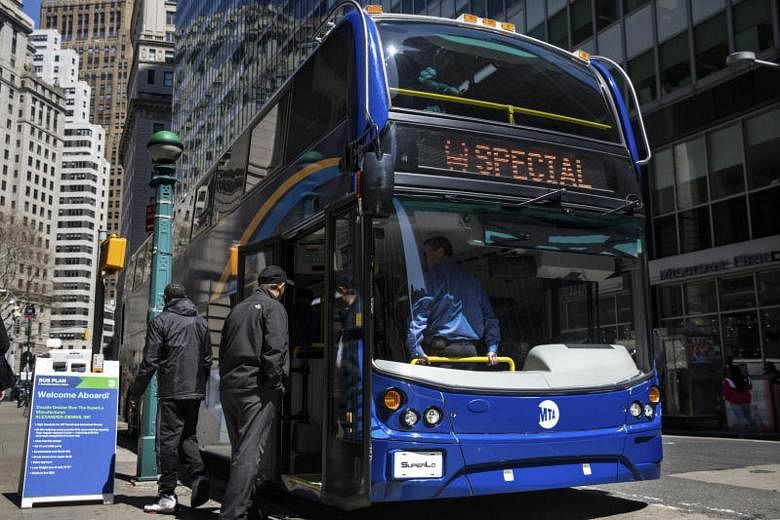NEW YORK (NYTIMES) - Double-decker buses. Entering a bus from any door. Digital signs showing when the next bus will arrive.
These are some of the improvements New York City's long-suffering bus riders were promised on Monday (April 23) as the Metropolitan Transportation Authority (MTA) announced a plan to turn around the sputtering bus system.
The city's buses have been plagued by sluggish service and declining ridership, even though the persistent problems have received less attention than the crisis facing the subways.
In his first major initiative, Andy Byford, the new leader of the transit agency that operates the city's subways and buses, released a plan to speed up buses.
"We know it's the right thing to do, and now we really want to push on and make this plan a reality and get people back on the buses," Byford said at an MTA board meeting in Lower Manhattan.
Transit advocates and board members - a notoriously difficult group to impress - quickly praised the plan.
Jaqi Cohen, the campaign coordinator for the Straphangers Campaign, an advocacy group, called it "one of the biggest wins for our city's 2.5 million daily bus riders in more than half a century."
New York City's buses are the slowest among major cities in the world, with buses in Manhattan moving at just 5.7mph (9.2kph) on average, according to the authority. A modernisation plan for the subway, which carries about 6 million riders each day, will be released in May.
The region is also struggling to respond to a broader transit crisis, with frequent problems on commuter railroads and bus lines.
On Monday, Governor Philip D. Murphy of New Jersey announced that New Jersey Transit would hire 40 new bus drivers as part of his proposed state budget.
"For all the discussion on rail, it's buses that make the show go in urban centers and urban communities," Murphy said at a news conference in Newark, with a shiny New Jersey Transit bus parked behind the podium.
After the MTA board meeting, Byford also stood in front of a shiny bus - this one a blue double-decker model similar to the iconic two-tiered red buses in London. The new bus was expected to run on the X17J express route between Staten Island and Manhattan as part of a pilot programme. Officials could order more double-decker buses in the future.
Double-decker models work better on express lines with fewer stops, Byford said.
"You can carry more people in comfort over these long-distance, limited-stop routes," Byford told reporters.
As part of the bus plan, officials promised a redesign of the entire system by 2021 and the expansion of all-door boarding by 2020 as part a new fare payment system.
They plan to expand a programme known as traffic signal priority, which allows a bus to hold a green light or shorten a red light, in order to keep buses moving. The proposal also called for digital signs showing when the next bus is due and urging state lawmakers to allow more cameras to enforce bus lane rules.
Byford declined to provide an estimate for how much the bus plan would cost. He argued that it would depend on how many bus lanes and cameras were ultimately installed and said that many of the costs could be included in the current budget.
Many pieces of the proposal will require the city's cooperation, but the initial reaction was positive. Polly Trottenberg, the city's transportation commissioner and an MTA board member, praised the bus plan.
"Some of these items are easy to do, and some are less easy to do. But we're really looking forward to working with you," Trottenberg said.
Bus ridership in New York City has declined, dropping about 14 per cent since 2007, even as the city's population has grown.
Fed up with slow buses, some commuters have switched to bicycles or ride-hailing apps like Uber.
Despite the flagging ridership, buses provide a critical source of transportation outside Manhattan, reaching into neighbourhoods that are far from subway stops. Bus riders also tend to be less well-off than subway commuters.
Governor Andrew M. Cuomo, who controls the transportation authority, recently revived a push for congestion pricing, a proposal to charge some drivers entering Manhattan to reduce gridlock and to raise additional revenue for public transit. But the idea failed to garner the support of state lawmakers, who instead approved a new fee on Uber and for-hire vehicles rides.
Peter Ajemian, a spokesman for Cuomo, said the governor supported the bus plan and urged the city to do its part to implement it.
"Much of the plan relies on the city's willingness to make improvements to the network and provide aggressive enforcement - we hope they will dedicate the necessary resources," Ajemian said.
Omar Vera, a transit enthusiast and frequent attendee at MTA board meetings, was beaming as he examined the double-decker bus and chatted with Byford, who has promised a more friendly and transparent approach.
"He is amazing," Vera said. "He's going to make the MTA great again."

